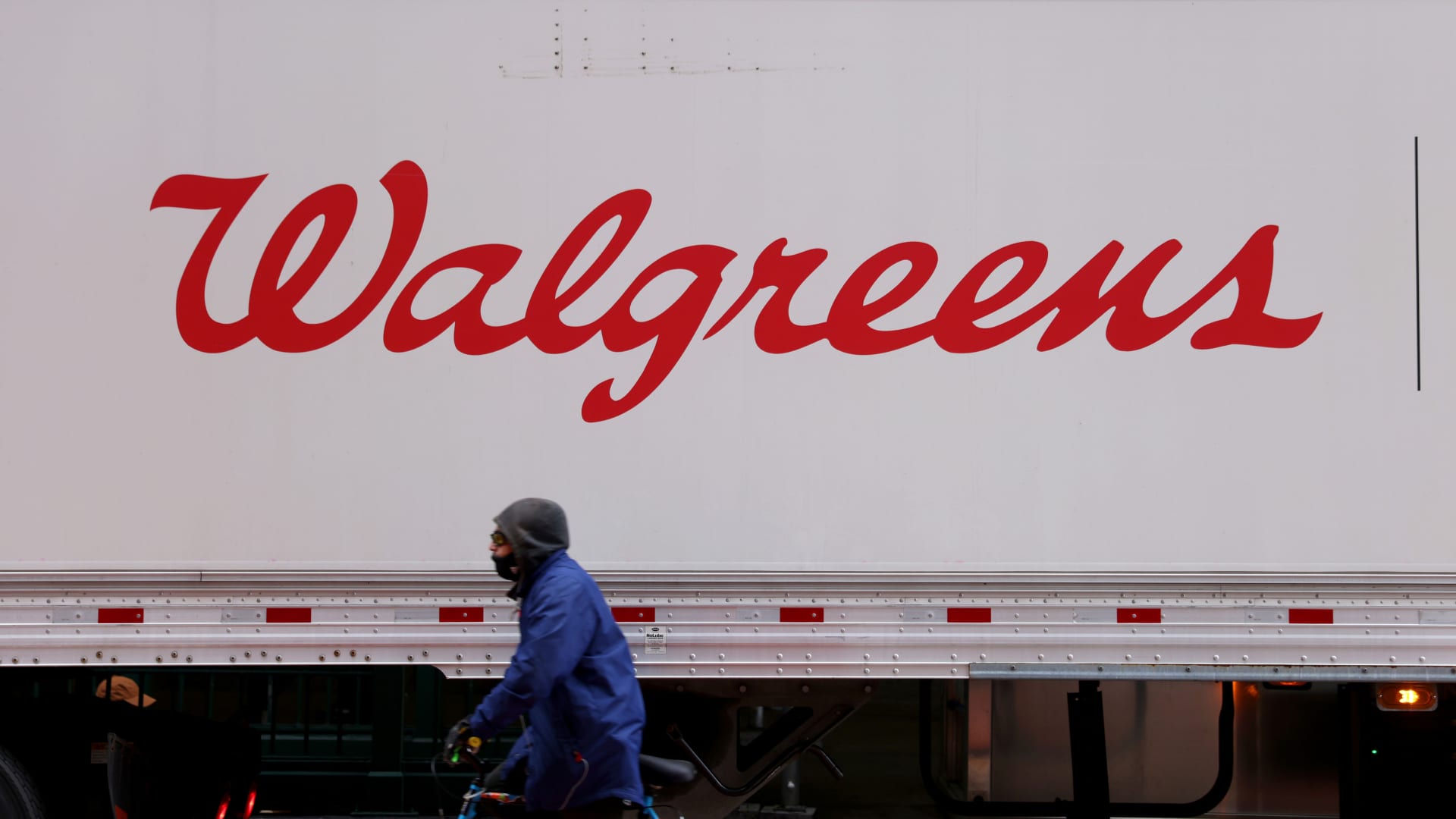A person drives past a Walgreens truck owned by Walgreens Boots Alliance, Inc. on November 26, 2021 in Manhattan, New York City, United States.
Andrew Kelly | Reuters
Walgreens on Thursday reported fiscal second-quarter sales that beat Wall Street expectations, but cut the top end of its full-year adjusted profit outlook in part due to a “challenging” U.S. retail environment
The company also posted a large net loss in the quarter as it took a large charge of nearly $6 billion related to the decline in the value of its investment in primary care provider VillageMD. Walgreens has closed 140 VillageMD clinics due to the company’s financial problems, which the company views as critical to its ongoing efforts to transform itself from a major drugstore chain into a major healthcare company.
But Walgreens does not believe the VillageMD indictment “will have a material impact on our financial condition or our ability to invest across businesses in the future,” Walgreens global chief financial officer Manmohan Mahajan said during a conference call Thursday.
The results come as Walgreens’ new CEO, Tim Wentworth, is working to cut costs and steer the company out of trouble with a slate of new executives. Shares of Walgreens fell 30% last year as the company faced weaker demand for Covid products, low reimbursement rates for pharmacies, an uncertain push into healthcare and a challenging macroeconomic environment.
In a press release Thursday, the company said it is confident it will achieve its goal of $1 billion in fiscal 2024 savings through its ongoing cost-cutting program. Walgreens has, among other things, laid off employees, closed unprofitable stores and used artificial intelligence to make its supply chain more efficient.
Here’s what Walgreens reported for the quarter compared to Wall Street’s expectations, based on an analyst survey from LSEG, formerly known as Refinitiv:
- Earnings per share: $1.20 adjusted versus 82 cents expected
- Revenue: $37.05 billion versus expected $35.86 billion
Walgreens cut its fiscal 2024 adjusted earnings forecast to $3.20 to $3.35 per share. This compares to the company’s previous guidance of $3.20 to $3.50 per share. Analysts surveyed by LSEG expect full-year adjusted earnings of $3.24 per share.
Walgreens said the new forecast reflects hurdles facing U.S. retailers and an early termination of its sales leaseback program. This also includes lower returns from Walgreens’ forward sale of shares of drug retailer Cencora, formerly known as AmerisourceBergen.
The company said stronger performance in its pharmacy services segment and a lower adjusted effective tax rate helped offset factors weighing on its earnings.
But Mahajan said Walgreens expects the current economic backdrop to “continue to negatively impact our U.S. retail sales in the near term.”
Wentworth noted on the call that the company is “exploring innovative ways to increase profitability and growth” in its retail pharmacy division, such as through new pharmacy reimbursement models.
The company did not provide a new sales forecast for the fiscal year. Walgreens hasn’t made that forecast since October, when it expected sales of $141 billion to $145 billion.
The company reported a net loss of $5.91 billion, or $6.85 per share, for the quarter. By comparison, net income was $703 million, or 81 cents per share, in the same period last year. A
Excluding certain items, including VillageMD’s $5.8 billion non-cash charge, adjusted earnings per share for the quarter were $1.20.
The company reported revenue of $37.05 billion in the quarter, up about 6% from the same period last year.
Walgreens is experiencing growth across all business areas
The company said this increase reflected revenue growth across its three business segments. But Walgreens’ U.S. healthcare division stood out as sales rose about 33% in the fiscal second quarter compared with the same period last year.
The segment’s revenue was $2.18 billion.
The company said the higher sales reflected VillageMD’s acquisition of multi-specialty care provider Summit Health and growth across all businesses in that segment on a pro forma basis.
VillageMD’s revenue increased 20% due in part to same-clinic growth. Sales at the segment’s specialty pharmacy business, Shields Health Solutions, increased 13% due to new contracts and expansions of existing partnerships.
Specialty pharmacies are designed to supply medications with unique handling, storage and distribution requirements, often for patients with complex diseases such as cancer and rheumatoid arthritis.
Walgreens and VillageMD
Source: Walgreens
Meanwhile, Walgreens’ U.S. pharmacy segment generated revenue of $28.86 billion in the fiscal second quarter, up nearly 5% from the same period last year.
This segment operates more than 8,000 drugstores in the United States that sell prescription and over-the-counter medications, as well as health and wellness, beauty, personal care and grocery products.
Walgreens said pharmacy sales rose 8.2% in the quarter compared to the same quarter last year. Comparable sales rose 8.7% due to price inflation in branded drugs and “strong execution” in pharmacy services, primarily driven by the company’s vaccine portfolio.
Total prescriptions filled in the quarter, including vaccinations, were 305.7 million, up more than 2% from the same period last year.
Retail sales fell 4.5% in the quarter compared to the same quarter last year, and comparable retail sales fell 4.3%. The company cited a challenging retail environment and a weaker respiratory season, among other factors.
Walgreens’ international segment, which operates more than 3,000 retail stores abroad, had sales of $6.02 billion in the fiscal second quarter. This is an increase of more than 6% compared to the same period last year.
The company said sales at its British subsidiary Boots rose 3%.
When asked in the call Eli LillyWentworth did not comment specifically on Wentworth’s new direct-to-consumer website, which aims to expand access to its weight loss drug Zepbound.
However, he noted that the company is a “natural partner” for pharmaceutical companies that “may want to go directly to patients for a particular product where the normal supply chain, reimbursement model, etc. does not work effectively.”
As an example, Wenworth pointed to GLP-1, a new class of weight loss and diabetes drugs that includes Zepbound. These medications must be taken chronically, but are expensive, which can be a hurdle for patients as well as health insurance companies and other payers.
Wentworth said Walgreens is “uniquely positioned” to distribute medications and serve as a “clinically aligned partner” that can help patients navigate their treatment safely.
Source link
2024-03-28 14:52:26
www.cnbc.com














